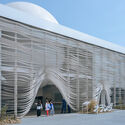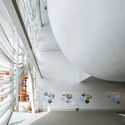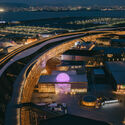
-
Architects: RAU Architects
- Area: 1157 m²
- Year: 2025
-
Manufacturers: Cooloo, Forbo, Het Anker, Kojima Shoten
-
Lead Architect: Thomas Rau

Text description provided by the architects. The Netherlands participates with a pavilion built entirely using circular principles and presented under the theme "Common Ground." The pavilion highlights the importance of international collaboration to tackle major global challenges such as accelerating the energy transition and keeping our planet livable. For six months, the Netherlands pavilion will also host an extensive program, offering Dutch businesses, research institutions, and organizations the opportunity to connect with Japan and build or strengthen partnerships.
































